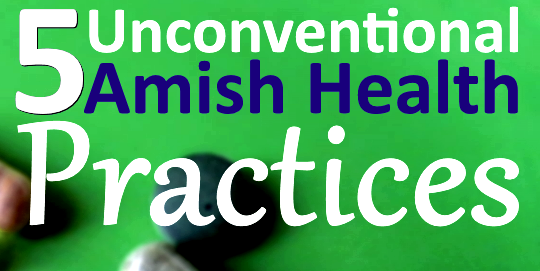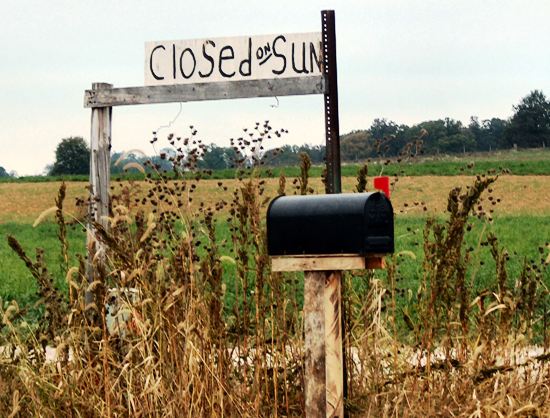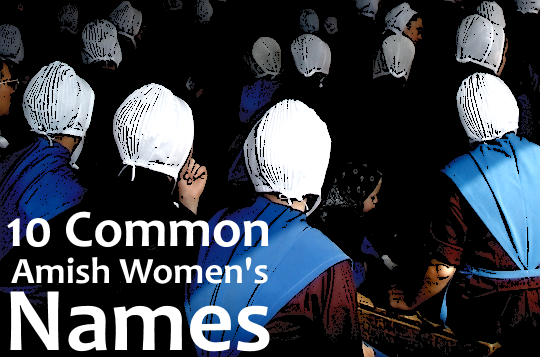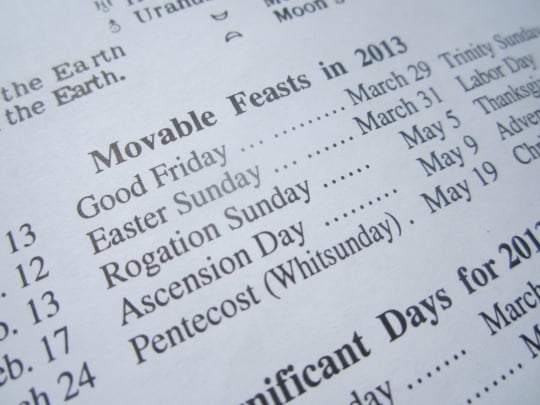5 Unconventional Amish Health Practices

Talking about the “Amish approach” to health care is nothing if not complicated. For one, with diverse churches and individual differences, it’s hard to say there is an “Amish approach”.
But one thing is for sure–many Amish people, admirably, care about their health. That’s the conclusion you have to draw after observing the efforts they put forth to get and remain healthy.
Amish people certainly do visit doctors and hospitals, but probably not nearly as often as non-Amish do, for a variety of reasons. There are a number of alternatives Amish make use of as well.
Even though some of these may be considered unorthodox, I’m not here to say they don’t work or aren’t worth trying. Clearly they bring some sort of benefit, though as you’ll see at least one of the categories below is highly controversial among the Amish.
Here are five health practices seen in various parts of Amish America. I’ve also noted how common each one is.
1. Traveling Long Distances for Health Care (fairly common)
Though “medical tourism” maybe isn’t the perfect term to describe what the Amish do, it’s within that same vein.
Amish will travel to other states or even spend days on a train to reach Mexico where they can access treatments unavailable in America, or undergo a medical procedure at a lower cost than in the US. Family may accompany the patient.

So if you’re ever in Tijuana, don’t be shocked if you see people in plain clothes. Clinics in the city have advertised in Amish papers such as The Budget. A 2006 Wall Street Journal article explained that with travel costs running even $4,000 per person, such medical trips are still economical.
An added bonus, Donald Kraybill explains in the article, is the opportunity for “a little diversion”, noting that “people who spend their lives in rural settings like to go to a motel sometimes, watch cable TV and eat in a restaurant.” The point is healing, of course, but the entertainment value comes as an extra.
2. Alternative Remedies and Treatments (common)
I have been the beneficiary of an Amish home remedy once or twice. The last time was when I was stricken with a fever, aches, loss of appetite, and flu-like symptoms while in Lancaster County.
So I guzzled a concoction my hosts had made of honey, lemon, pepper, and horseradish. Next step? Crash in the recliner by the steady heat of the wood stove, and conk out for a few hours.
By the next morning I was back on my feet. Was it thanks to the remedy, a good night’s sleep, the bug naturally running its course, or some combination of all three? No way to tell, but I was happy to hit my ailment with everything at my disposal, including this extremely strong-tasting drink.

Treatments in this category include passed-down family remedies, herbal and other “natural” treatments, and practices such as chelation therapy. Chiropractors also do good business in Amish communities.
Unfortunately an openness to medical alternatives can lead to charlatan types who take advantage of cure-seekers. The authors of An Amish Paradox refer to a “worm doctor” operating in the community who suggested the source of any ailment was a parasite that needed killing (p. 236).
This category does not include “folk medicine”, which we look at next.
3. Folk Medicine (minority practice)
A separate category of folk medicine would encompass brauche practices (also known in other contexts as folk healing, sympathy curing, or pow-wowing). I want to be clear that this one is controversial among the Amish.
A folk practitioner may provide healing services such as “pulling out” stomach aches and other ailments. Traditionally the practice uses “words, charms, and physical manipulations” to achieve healing (see “Health and Health Care Decision-making: The Old Order Amish”, Anna Frances Z. Wenger p. 95).
An Amish friend in a progressive settlement joked about these old folk practices, considered outdated or questionable by some or even “witchcraft” by others. Truth be told I’ve rarely spoken to Amish people about folk and fringe practices, though you read and hear enough here and there to know that they still exist.

For example, Karen Johnson-Weiner addresses “pain-pulling”, known as shmates tsia among Swarztentruber Amish, in her book New York Amish. “No longer widely practiced in Old Order Amish communities, pain pulling is considered extremely hard work.” Not everyone can do it; there is a belief that the skill runs in families. As described the practice involves multiple people holding hands to pass pain through a line, with a copper wire used to finally pass the pain into the ground (p. 69-70).
Brauche is described by another researcher as creating “high context relationships” leading to visiting and personal contact. She also notes that brauche services may be favored to treat babies, who cannot express what is bothering them (see Wenger, p. 93-97). So if we are looking for an explanation as to its appeal, that is one possibility.
Other reasons? In An Amish Paradox, Charles Hurst and David McConnell write that “Powwowing, though controversial for some Amish, shows no signs of completely disappearing because of the increasing costs of mainstream medicine, the rise in acceptance of alternative medicine, and the continued belief by some in the reality of curses and hexes.” The authors describe such practices as “most likely among very conservative groups” (p. 237-238).
4. Multi-Level Health Marketing (common)
Multi-level supplement marketing is where health evangelism and Amish entrepreneurialism meet.
It’s hard to find an Amish publication that doesn’t have some kind of advertisement for a health product you can order by mail. But a more potent form of sales is word-of-mouth–which can be exceptionally effective in Amish communities (for good, or ill).
Users of a product suggest it to friends and loved ones, and receive a portion of the profits from any ensuing sales.

This could be classed as both a business and health practice. Multi-level marketing is of course common among English too, but it has the potential to thrive in a population with many close personal ties and a high interest in health.
Personal testimonials are often used as selling points in health marketing and can be very convincing coming from a friend or family member.
Some even convince those outside their circles–I was a semi-regular purchaser of a joint-boosting supplement for a little while, courtesy of an Amish acquaintance in Holmes County, Ohio. Did it help my achy knees? Well, they still work eight years later.
5. Home Birth (common)
Having a baby, if you’re English, is a monumental happening–in some cases literally a once-in-a-lifetime occasion. In contrast, for many Amish families, the birth of a child is a seasonal event.
That’s not to downplay the joy at a new arrival, treasured as a blessing by Amish parents. It’s just a way of saying that Amish are more experienced at childbirth.
And with that experience, they know what they prefer. While many Amish mothers give birth in hospitals, some opt for alternatives. These include midwife-assisted birthing centers and home births.

Probably the best account if you want to read firsthand stories of home birth is found in House Calls and Hitching Posts (by Dorcas Sharp Hoover), about the career of Dr. Elton Lehman, a country doctor who catered to Amish in the Holmes County community. It includes stories of one particularly well-known Amish midwife.
Home birth is a fringe practice in English society, but for experienced Amish mothers in particular it can be a comforting, preferred way to have a child. It’s also a lot cheaper than a hospital delivery. And when it’s 8, 10 or more children in a lifetime, that adds up.
Image credits: Green pills photo- Shannon Kringen/flickr; Amtrak- Bruce Fingerhood/flickr; Onion- Br3nda/flickr; Barn & Amish home- ShipshewanaIndiana; Body Balance- Life Force International











I don’t know if you would include this here or not, but I would say that an Amish/Mennonite belief in the power of prayer for healing is becoming more “unconventional” as this world drifts farther and farther from God and a sense of His divine power.
Good point Forest, thanks for adding that.
I would also add that some of these may be closer to “conventional” or widely-accepted than the title might imply–alternative treatments and supplements, for one, which is actually a big industry. At what point does “alternative” stop being alternative?
As it happens, I recently shared a waiting room at a specialist’s office with two different Amish patients, one of whom had her family with her. It was interesting to hear them conversing in “Dutch” with the occasional word of medical jargon in English: “(something, something) chemo (something, something) treatments …”
Around here, one routinely sees Amish at conventional doctor’s offices and hospitals. I am also aware that they have their own version of “insurance” in some of their communities (though it’s not called that) in the form of communally administered bank accounts that help pay in case of emergencies. However, knowing how expensive a cancer diagnosis can be, I would think one sick person could deplete the fund in a month, and this community clearly had at least two people at once. I found myself wondering about the issue of how the Amish pay for expensive forms of healthcare.
Does anyone have any insight?
As I understand with huge costs there is the option of reaching beyond the immediate church to other churches or even communities. How often that option is taken I do not know. Also benefit auctions and other fundraisers may come into play. We’ve seen an example of that with the Hertzler baby case in New York, and family reaching out even to the public to promote benefit events like a breakfast and benefit auction:
https://amishamerica.com/amos-hertzler-benefit-breakfast/
https://amishamerica.com/amish-public/
When Church Fund is “maxed out,” Almosa Geld or Alms Money kicks in. This is the money that is collected twice a year at communion services. Once the year’s bills are tallied, each district will be given a report what was spent and if there is not enough in the fund, an additional collection will be asked for to cover the short-fall. (Though I don’t remember this happening lately.) Besides that, there are announcements made in church that so-and-so’s bill after Church Fund came to $$$$ and they are asking for $$$ per member. That is free-will so those who can’t spare it are not obligated, but many will give more than the suggested amount. $10 per member in a community this size is a lot.
Thanks for your always-helpful detail Mark. I believe when I was in church in Indiana the medical bill needs of another church were raised at the end of the service. Does this ever happen in your community?
Yes. Though it is often from related churches, we will sometimes be told of large bills from other states or communities where we might not know the people at all.
Thanks Mark!
You are welcome, Erik.
Thanks for answering my question, Erik and Mark!
When I was at the doctor’s office today, I again ran into one of the Amish families, and something occurred to me that hadn’t before: I asked them if they had to pay someone to drive them, and they said yes. I told them of a local charity that is doing my driving for me. I hope they will look into it! That expense could add up fast, too.
The multi level aspect has also been controversial among some individuals in Anabaptist groups. The recent “plain interests” publication has an interesting article in it from a couple who are obviously against it.
Multi-level Marketing in Amish communities
Interesting Jerome, it has also been addressed in “The Problem Corner” in Family Life before by an Amish couple who wrote in on the topic.
On the one hand I see the popularity of MLM sales as a natural outgrowth of conviction in a product plus the entrepreneurial spirit a lot of Amish people possess, bolstered by the many connections and relationships Amish people tend to have providing a ready market.
At the same time I also appreciate the concerns and criticisms. The gist of the letter-writer’s concern is in these lines: “Is it right to encourage people to buy these expensive products when we know the reason they are so expensive is because of the sales program, and because so many people are making big money off of them? Did God plan that our bodies should depend on products such as these in order to stay healthy?”
The editor writes that they received many replies, and printed quite a few with strong opinions supporting both sides. This is from a 1994 issue of Family Life which tells us the MLM issue has been around a long time.
Folk medicine and Powwowing
I thought it interesting that they consider Folk Medicine the same thing as Powwowing.. To me and historically, Folk Medicine was/is that sort of concoction that you drank at your friends house.. Vinegar to cure acid stomach, eating lemons to clean oneself of germs before holding a new baby, aloe vera to stop pain & heal burns/wounds, the root of comfrey to speed up healing.. Many having been proven to have some basis in fact but in the old times, they didnt know how but they knew it worked..
Powwowing on the other hand sounds to me is more of a spiritual type healing.. It sounds very similar to some of the healing modalities in meta-physics such as reike or hands on healing.
Of course, where a healing practitioner claims these “powers” originate matter as well.. One person could do one thing & say it is from God & it is widely accepted, whereas another will do the same thing & say they are witches and it comes from the Devil and they are seen as evil..
Personally I believe ones spirit and intention is what matters in this regard..
I’ve seen & heard some pretty weird stuff in my life..
What's the best term?
The terminology is a little confusing to me too because previously I thought of folk medicine similarly to what you describe, however a number of sources (see below) use “folk healing” or “folk medicine” in the context of powwowing.
It may be that powwowing is better described as an element of folk medicine, and the section above might be better titled “folk healing” or just “powwowing” or another synonym. Likewise these natural treatments you describe maybe could be considered “folk remedies” which sounds lighter. Just speculating, maybe someone with deeper knowledge of the practice can help here.
“Powwowing in Union County : a study of Pennsylvania German folk medicine in context” by Reimensnyder, Barbara L. http://repository.upenn.edu/dissertations/AAI8217169/
https://books.google.pl/books?id=lfjrUfeaujcC&pg=PA283&lpg=PA283&dq=Hostetler,+John+A.+1976.+%E2%80%9CFolk+Medicine+and+Sympathy+Healing+among+the+Amish.%E2%80%9D&source=bl&ots=vsjLlL_d2n&sig=4kng-CO-2xE-JnJQl0n45m-AzUQ&hl=en&sa=X&ei=RafTVNmYJ4LraLGvgdAI&ved=0CCoQ6AEwAg#v=onepage&q=folk%20medicine&f=false
https://books.google.pl/books?id=aYBcX3a1F0wC&pg=PR6&lpg=PR6&dq=Don+Yoder%E2%80%99s+%E2%80%9CHohman+and+Romanus:+Origins+and+Diffusion+of+the+Pennsylvania+German+Powwow+Manual%E2%80%9D&source=bl&ots=EDaKv8t42x&sig=g0WVdl870gzWRbNLcGJVoC8PaGQ&hl=en&sa=X&ei=1avTVIPEBcfraJfygbgK&ved=0CDcQ6AEwBg#v=onepage&q=Don%20Yoder%E2%80%99s%20%E2%80%9CHohman%20and%20Romanus%3A%20Origins%20and%20Diffusion%20of%20the%20Pennsylvania%20German%20Powwow%20Manual%E2%80%9D&f=false
"Brauche" and "powwowing"
Also confusingly, some distinction is made in at least one source between Brauche and powwowing (while other sources treat the terms as synonyms). This is from John Hostetler’s “Folk Medicine and Sympathy Healing Among the Amish” (1976):
“There are several Amish folk practitioners of varied reputation. One regularly visits Amish communities in several states in the interest of “curing”. He claims to possess a special gift of healing. He asserts that his practice is neither Brauche nor powwowing but says he can tell what is wrong with a person by simply laying his hands on that person.”
Whatever the best title may be, I meant this category to cover those practices which don’t have a conventional or alternative medical basis but rely on an unseen power that the practitioner possesses or upon objects or words or actions believed to possess a healing power unexplained by science.
Maybe this will further explain these terms Erik. In my blog post about Amish Stereotypes, read the comments where Braucherei & Pow Wow comes up.
http://brendanixononamish.blogspot.com/2014/02/breaking-amish-stereotypes-every-day.html (the link doesn’t hyperlink here, so you’ll need to copy & paste in your browser)
Thanks. The gist of this question is which is the best term to refer to which practice(s). As I wrote above there seem to be different terms and different ways of using them. For example quite a few sources treat brauche and powwowing as synonyms, but in the Hostetler article his wording suggests there is a difference (“…neither Brauche nor powwowing…”). Also the term “folk medicine”. I guess it’s mostly a language question.
Brauche
In the small church where I spent the first thirteen years of my life we had an old (very old, I thought,practically in his 70s:) man who they said did brauche.
My mother was leery of it, not sure whether it was good or a bit darker, but the old man’s son in law, with whom the old man lived, was a preacher, seemed OK with the old man’s beliefs and skills. I remember the old man also taught us how to get rid of a wart: Rub a penny on it thoroughly and then isolate the penny. I must confess I still do the penny bit. lol
In Amish stores that carry herbs and herbal remedies, I have observed that there seem to be just as many non-Amish customers as Amish customers for these products.
I think another source for financial assistance for medical bills for Amish and plain Mennonites, are the “Showers” listed in The Budget newspaper. Not all “showers” include requests for money;
some are requests just for get well cards, letters, etc. Typical
wording when money is being requested seems a little subtle such
as, “Let’s remember so-and-so who just had major heart surgery.
Medical expenses are high and he will be unable to work for 8
weeks.”
powwowing
Wow! My wife is way into Beverly Lewis books so I thought I would see what all the fuss was about. I read “the postcard” and “the crossroad” in which this was a major source of controversy in the community. I figured that Lewis made this up as a way to spice up the story. I had no idea that this was a real issue!
Opinions on "drawing pain"
Well, as noted above, these are minority practices, but evoke controversy. Family Life’s Problem Corner discussed the issue of drawing pain, along with reflexology, in the May 2011 issue.
Here are a few of the responses, on drawing pain (I can’t say with certainty that these are Amish writers, as they are anonymous and don’t self-identify as such, but given the publication’s readership and content of these letters there is a decent-to-likely chance they are):
-“I cannot answer your question on reflexology, but we have had some experience with “drawing pain”. In our community, we had a single sister practicing this. We did not see this as a gift from God, as some do. This sister was not confronted, but only prayed for. Sometime later she felt convicted about this practice. She prayed and asked that God would take away the gift if it was not from Him. Sometime later she realized she could no longer do this. No more burping, etc. when she held a fussy baby.” -Also wanting to do what is right
-“All I can say is the power to “draw pain” was in me when I was born and I feel it’s something Jesus gave me to heal. I don’t have to know of other people’s problems, just to be in the same room with them, I can, in a hurry, feel sick and often don’t know why.
I feel some others have the same ability with rubbing feet.” -Iowa
-“I was taught these things are wrong and do not belong to Christians. Yet in our small community nearly everyone practices these things and I am persuaded to do the same. What do I do when someone demands I let them “draw the pain” from my fussy child? Some will not take “no” for an answer. -No name or state, please
I’d guess Amish people who are not involved in this practice (again safe to say a majority of Amish) would have opinions similar to the first and third writer. It’s another example of Amish diversity, though maybe one that is less comfortable to discuss.
Eric
That article in “Family Life” must have been before I was a subscriber, but it would be interesting to read the various replies as I am a member of a multi level marketing group through some Old Order Mennonite friends. If you know anything about the “pigeon king” scandal from several years ago it’s understandable why there would be some reserve about that technique of business among some, which was a point brought out in the “Plain Interests” article.
Yes, that is understandable following what happened with Pigeon King.
Unfortunately I can’t reproduce the replies here (there are 5 pages worth) but I can tell you the editors printed 10 reader replies I would class as “negative” or “be cautious” and 5 I’d consider “positive” or “neutral”.
It’s the August/September 1994 issue if you can get old copies of Family Life somewhere.
Yes, powwowing is used in SOME groups, and is quite controversial. Never wasn’t making it up☺
Sorry… “Beverly” wasn’t making it up!
Swartzentruber Practices
I know. . .I speak from the Swartzentruber Order POV. But, that’s where I have most of my ex-Amish family and friends 🙂
Among Swartzies, there’s a resistance to seek outside medical help. Our SIL’s mother has intense diabetes but, refuses to go to a doc or hospital to treat her skin sores. She also refuses to do any diabetes treatment that would incur an electric machine in their home. Consequently, she’s lost her eyesight & has recurring skin sores.
Another Swartzentruber Amish man wouldn’t convince his wife to immunize herself and the children when the Ohio measles outbreak occurred last year. When I asked him, “What if the children get measles or would die from another disease?”
He replied, “It’s God’s will.”
Our ex-Swartzie “daughter” Sarah – while growing up – went to a chiropractor for all her health ails. Even after she left, and fell, and fractured her ankle, she insisted on a chiropractor. In her settlement, the chiropractor was the “doctor” for everything – even her addiction to laxitives.
Our ex-Swartzie “nephew” either self-diagnoses via the internet or suffers in silence, refusing to see a doctor. Sometimes, I think it’s the financial commitment that is off-putting. He also refused the free measles vaccine when Ohio had its measles outbreak.
Our “sons” Monroe and Mosie have never had any immunizations. I’m not wanting to get into the immunization – or not – discussion, just saying that in my experiences this order has unconventional health practices.
Our SIL now seeks professional healthcare – if he can’t tolerate an illness – but that’s because he’s married to our daughter. . .a RN. 🙂
Also on health practices, the former-Swartzies I know have told me about their unlicensed dentists who pull teeth. I wrote a blog post about that on my Beyond Buggies & Bonnets blog.
Herbalists
At one time there was an herbalist/natural practitioner is the Hicksville, Ohio/Spencerville, Indiana area. During several visits to this herbalist I encountered Amish who much preferred the herbalist to the medical doctor and hospital.
5 Unconventional Amish Health Practices
Everything is very open with a really clear description of the issues.
It was really informative. Your site is very helpful.
Many thanks for sharing!
Providers
Is there a resource list for plain sect health care providers in Lancaster County?
Old ways
As we have “Pennsylvania Dutch”, (Amish/Mennonite) roots, I don’t find it at all odd to use the old ways to heal. This is most helpful since we seem to find Doctors who simply want to prescribe pain pills rather than address the issues.
Amish in Mexico
I’ve been a patient of Dr Castillo n Tijuana Mexico for 29 years.
Amish, Mennonites, Hutterite’s are always there.
They arrive by train.
I’ll never forget Crist, , he arrived with a tumor on his neck bigger than my fist.
It reduced and disappeared from all the treatments there.
It’s always nice to see them.
Research parasites. He wasn’t wrong.